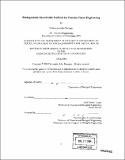Biodegradable microfluidic scaffolds for vascular tissue engineering
Author(s)
Bettinger, Christopher John, 1981-
DownloadFull printable version (5.765Mb)
Other Contributors
Massachusetts Institute of Technology. Biological Engineering Division.
Advisor
Robert Langer.
Terms of use
Metadata
Show full item recordAbstract
This work describes the integration of novel microfabrication techniques for vascular tissue engineering applications in the context of a novel biodegradable elastomer. The field of tissue engineering and organ regeneration has been born out of the high demand for organ transplants. However, one of the critical limitations in regeneration of vital organs is the lack of an intrinsic blood supply. This work expands on the development of microfluidic scaffolds for vascular tissue engineering applications by employing microfabrication techniques. Unlike previous efforts, this work focuses on fabricating this scaffolds from poly(glycerol-sebacate) (PGS), a novel biodegradable elastomer with superior mechanical properties. The transport properties of oxygen and carbon dioxide in PGS were measured through a series of time-lag diffusion experiments. The results of these measurements were used to calculate a characteristic length scale for oxygen diffusion limits in PGS scaffolds. Microfluidic scaffolds were then produced using fabrication techniques specific for PGS. Initial efforts have resulted in solid PGS-based scaffolds with biomimetic fluid flow and capillary channels on the order of 10 microns in width. These scaffolds have also been seeded with endothelial cells and perfused continuously in culture for up to 14 days resulting in partially confluent channels. More complex fabrication techniques were also demonstrated. A novel electrodeposition technique was used in the fabrication of biomimetic microfluidic masters. Thin-walled devices were also synthesized to accommodate the relatively low gas permeability of PGS.
Description
Thesis (M. Eng.)--Massachusetts Institute of Technology, Biological Engineering Division, 2004. Includes bibliographical references (leaves 91-93).
Date issued
2004Department
Massachusetts Institute of Technology. Department of Biological EngineeringPublisher
Massachusetts Institute of Technology
Keywords
Biological Engineering Division.